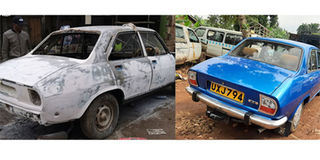Prime
I used Shs18m to restore my Peugeot 504

What you need to know:
John Bosco Isunju had enjoyed many rides to school in his father’s Peugeot 504. However, when it developed mechanical issues and his father could not afford maintenance fees, it was parked in a nearby banana plantation for 25 years. In 2020, Isunju embarked on a journey to restore it to life.
It is hard to believe that John Bosco Isunju’s 1979 Model Peugeot 504 was once left to rodents. For 25 years, it was parked in a banana plantation and rotting away.
Its first owner was Bosco’s father John Baptist Isunju who bought it from a friend at Shs4.5m in 1992. Isunju drove it until 1995 when it developed mechanical issues and since he had retired from his job, maintaining and servicing the now 42-year old car became a challenge.
“My brothers had enjoyed many rides to school in this car. Now parked, we would sit in it and turn the steering wheel,” Bosco says.
For the 25 years it was parked, Isunju says none of the family members thought of restoring it. It was until January 2020 after completing school and working for some time that Bosco agreed with his brother, James Walter to restore the car. Walter hired a carrier to transport the Peugeot to Kampala from Fort Portal City as Bosco sourced for a mechanic to carry out the repairs.
Finding spare parts
One of Bosco’s working trips to Jinja in early January 2020 saw him come face to face with a Peugeot 505 model that seemed to be in good condition. He found out its details, including the possibility of buying it.
“The purpose was to identify parts of this car that could be fitted onto the family car I was restoring. I eventually bought the 505 Peugeot at Shs1.6m. Its parts, such as the tyres were still usable and its engine could start. The restoration process started in January 2020,” Bosco explains.
During the restoration process, on a short trip to Nairobi, Bosco bought spare parts such as the clutch and pressure plates, headlights, door rubbers and a few others the mechanic had recommended. Upon returning to Kampala, some parts such as the pressure plate could not work well. An engine test showed that it could start but produced weird sounds. The gearbox also had a leakage and was replaced. The front suspension system that made noise during test drives was also replaced.
The engine valves also leaked oil that damaged spark plugs. It was later opened for overhauling. The old carburetor that consumed a lot of fuel was also replaced for a smaller one that’s fuel saving. The fuel tank was opened, welded and cleaned because it had rusted. The manifold for the exhaust system and the silencers, were all replaced, among many other parts, including the interior, whose seats were replaced.
“Some of the parts that were a nightmare to replace included the brake line because of the brake booster. I tried many parts but was later told to try those of a Land Rover that eventually worked,” Bosco recalls.
The restoration process cost approximately Shs18m, including the cost of buying the Peugeot from Jinja, transportation from Fort Portal, spare parts from Nairobi and labour for mechanics.
Car specs
Today, Bosco’s Peugeot runs on a 1800cc petrol engine. It is now a right hand drive because the restoration process saw the mechanic use modifications from the 505 Peugeot. For service, Bosco says spare parts are sourced from different dealers in Kaleerwe and Ndeeba, both Kampala suburbs.
To avoid overuse, Bosco says he only drives the car at the weekend, to functions, and rarely to work. He also drives it to vintage shows and when he is stressed.
“One or two kilometres are enough to get compliments to take away all the stress. Many cheer and thank me for keeping the car in a good condition even when they have no idea what I went through and how much it cost me,” Bosco says.
When pressed on its resale value, Bosco says he would first consider if he can replace it before cashing in. Its value is not monetary to him and the family. However, if someone insists on buying it, Bosco says he cannot let it go for anything less than Shs30m.
Background
Peugeot’s flagship, the 504 made its public debut on 12 September 1968 at the Paris Salon. The press launch, which had been scheduled for June 1968, was at the last minute deferred by three months, and production got off to a similarly delayed start because of the political and industrial disruption which exploded across France in May 1968.
The 504 was a sunroof-equipped four-door saloon, introduced with a carbureted 1796 cc four-cylinder petrol engine 97 bhp.




